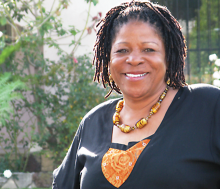Incarceration

Author and reporter Maia Szalavitz says America is long overdue for new thinking on addiction, "both because our understanding of the neuroscience underlying addiction has changed and because so many existing treatments simply don’t work.” Our friends at Juvenile Justice Information Exchange sat down with Szalavitz to discuss her new book on the topic, Unbroken Brain: A Revolutionary New Way of Understanding Addiction. The following has been edited for length.

The solution to our awful prison problem is contained in the story of Gov. Edgar, Ratliff, and Celestial Ministries: Make a preferential option for those who are most impoverished in our midst. We might fund these efforts by taking money away from the corporations promoting criminal attacks on innocent people in other lands.

“We believe in the value, power, and potential of training to produce more effective, more capable, and better police officers,” the Ferguson Commission wrote. I believe in this, too. And I believe that investing in a better police force may yield a future where “liking the police” is no longer a privilege, but the norm.
1. Mourning Prince and David Bowie, Who Showed There’s No Right Way to Be a Man
“… We’ve lost two men who had an expansive, almost luxuriant vision of what it meant to be a man and lived out that vision through decades when it was much less safe to do so.”
2. On Earth Day, a Look at How Americans View Environmental Issues
Should the country do whatever it takes to protect the environment? The number of Republicans who say “yes” has decreased in the past 12 years.
3. Wage Gap Alarm Clock Rings After 79% of the Work Day Is Done So Women Can Go Home
Brilliant.

LAST JUNE, COLUMBIA UNIVERSITY sold all of its shares in the Corrections Corporation of America, the largest private prison corporation in the country, and in G4S, the world’s largest private security firm. In doing so, Columbia became the first U.S. university to completely divest from the $74 billion prison industry.
Though the total amount Columbia divested, roughly $10 million, was not a major financial loss for either company, it was an important win for the students who had been pressuring the university to divest since 2013. “We work in the context of a bigger movement that seeks to break down the notion that prisons and police can solve our problems,” said Asha Rosa, a student organizer with Columbia Prison Divest, part of Students Against Mass Incarceration at the university. “We aim to create a world where people understand that investing in something like a prison is a socially toxic investment.”
Other universities and nonprofits followed suit: In December 2015, the California Endowment—a private, statewide foundation that focuses on health and justice for all Californians—announced it will no longer make direct investments in companies profiting from for-profit prisons, jails, and detention centers. A few weeks later, the University of California divested $25 million. And similar student-led divestment campaigns are underway at universities around the country, including UC Berkeley, Brown, Cornell, and the City University of New York.
For many organizations, the decision to divest from the prison industry is rooted in the organization’s own mission. Divesting is about not wanting to invest “in anything that hurts the people we are trying to support,” explained Maria Jobin-Leeds, a board member of the Schott Foundation and the Access Strategies Fund, two foundations committed to improving the lives of underserved communities, including communities of color. And given the disproportionate impact that mass incarceration has on people of color—in a 2015 speech, President Obama cited a “growing body of research” that shows people of color are more likely than whites to be arrested and more likely to be sentenced for similar crimes—both foundations decided to divest. “Companies that profit from prisons make money off the poorest and are supported by a deeply racist system,” said Jobin-Leeds. “We do not want to make money off this system.”
Profiteers and private prisons
But despite this conviction that divesting was the right move, Jobin-Leeds and her fellow board members realized it wasn’t easy to determine which investments were connected to the prison industry. One reason this was difficult was because of the overall lack of transparency within the prison industry. So while an investor could reasonably deduce that the Corrections Corporation of America manages prisons, she wouldn’t necessarily know that the CCA—like many private prison management companies—has a financial incentive to keep more people in prisons. Which it does: According to a 2013 report, 65 percent of private prison contracts with state prisons regularly stipulate occupancy quotas requiring the state to make payments for empty cells—a de-facto “low-crime tax.”

On Oct. 27, 1994 — 21 years ago today — the U.S. Department of Justice reported that the United States’ prison population had reached over 1 million people. By comparison, that’s the same size as San Jose, Calif.— the tenth biggest city in the US.
Today, the United States’ prison population is over 1.5 million — the size of Philadelphia, Pa., our nation’s fifth largest city.
Yet the size of our prison population — the largest in the world — is only part of the problem. Communities of color and poorer communities are disproportionally sentenced to prison — the result of systemic injustices including income inequality, school-to-prison pipelines, and racial profiling.
We mark many positive anniversaries here at Sojourners, but the work of justice also necessitates recognizing ongoing abuses of human dignity over time. So today, on the grim anniversary of 1 million people housed in our prison system, we choose to remember them and all those still behind bars. Here are ten articles we’re re-reading today about mass incarceration — and how to end it.

CRIMINAL JUSTICE REFORM in the United States is gaining momentum with each graphic video showing fatal police abuse. In the aftermath of the many deaths of unarmed black men and women and the city-wide protests that erupted in Ferguson, Baltimore, and Cleveland, it is not surprising that presidential hopefuls are making bold public statements about the need to change a system that is profoundly unjust, overly punitive, and excessively costly to run.
At the other end of the spectrum, away from TV cameras and political wrangling, activists such as Tara Libert and Kelli Taylor, co-founders of the Free Minds Book Club and Writing Workshop, are dealing with decades of draconian anti-crime policies that have resulted in mass incarceration rates marked by racial disparities that have had a devastating impact on families and communities.
The numbers speak for themselves. Although the United States makes up less than 5 percent of the world’s population, it has nearly 25 percent of its prison population. According to The Sentencing Project, a research and advocacy organization working to reform the U.S. criminal justice system, more than 2.2 million Americans are now locked up in prisons and jails across the country—a 500-percent increase over the past 30 years. Furthermore, those who are incarcerated come largely from the most disadvantaged segments of the population.
THREE DECADES AGO I did a four-year stint behind bars. I wasn’t incarcerated—I worked as a correctional officer at the maximum security jail for the Pinellas County Sheriff’s Office in Clearwater, Fla. It wasn’t a career I planned on pursuing.
After high school, I couldn’t afford higher education. I earned an associate’s degree from the local community college, working initially at a video game arcade, then at a factory my dad owned. At the time, I was thinking about a career in law, so my mother and stepfather, both of whom were patrol deputies, suggested that I apply for a job at local law enforcement agencies in order to pay my way through school; the sheriff’s department where they worked ended up hiring me. That’s how I earned my bachelor’s degree while working full time as one of the youngest correctional officers at the jail.
During the semesters I worked the night shift at the jail, I took classes during the day; when I worked the day shift, I took night classes. The contrast between the classrooms and the battleship gray corridors lined with steel-barred cells was striking. At the time, I did not like the jail job; I couldn’t wait until I could “escape” to graduate school.

It’s no secret that the prison population in the United States has exploded in recent decades. We incarcerate our citizens at higher rates than any other developed nation. The federal prison population has increased by almost 790 percent since 1980. The number of children with one or more incarcerated parents has increased at an astonishing rate of 80 percent since 1991.
The mass incarceration of mostly Black and Latino men and women has moral implications in two ways. First, our current “tough-on-crime” approach to criminal justice has cost taxpayers a substantial amount with little effect on crime rates. These tax dollars could be spent instead on education, mental health, or drug rehabilitation. The way we spend public money reflects our public values. (Sound familiar?)
In addition, there are far-reaching moral implications of the act of naming someone “criminal." This label is inhumane, unjust, and unholy.
The “criminal” label has devastating effects on quality of life and equality of opportunity for many individuals. It is nearly impossible to shake. Most federal education grants are not available to someone with a criminal background. In many cities, access to subsidized or public housing is banned based on arrests or incarceration. Many states ban those with criminal backgrounds from food stamp eligibility. Being forced tocheck the box on an employment application indicating a past felony conviction essentially lands that application in the trash. The Sentencing Project estimates a total of 5.85 million people have been banned from voting because of a past conviction.
But Christians have a unique, biblically-based perspective on labels. In Christ, “sinners” become “beloved ones." The excluded, hated, and oppressed become included, wanted, and loved.

One time I took a group of people in the drug rehab program to the local zoo. Most of our group had been to prison – some for years. Most were felons. Most of the women had been prostitutes as well as addicts. Most of them had been homeless, had lengthy criminal records and had, as a group, used virtually every drug — heroin, meth, crack cocaine — and had used every deception, scam, or theft to acquire their drugs. In short, they had been desperate in ways and to a degree most of us could never imagine. If you think a hungry man will commit extreme acts for food to keep from starving, an addict will commit acts a hundred times more extreme. There are few acts an addict will not do.
And yet, few of these former addicts had ever been to a zoo.
One of these people, a woman in her mid-40s, couldn’t contain her excitement as we walked into sight of the resident animals. She shrieked and ran from exhibit to exhibit — until she saw the elephants. We happened to catch the trainer as he was giving a little question-and-answer time. This woman had endless, little kid-type questions about how elephants ate, slept, how they lived, and where they came from.

Before selling illegal drugs, Dejarion Echols worked several years for a youth correctional agency and a psychiatric residential-treatment facility for teenagers. He decided to pursue a college education but couldn’t afford to be a full-time student. Desperate to make money, the unemployed, 23-year-old, engaged father of two sold crack cocaine for six months in 2004.
Any chance Dejarion had for a meaningful, productive life quickly ended. On a tip, police searched his home, found 44 grams of crack cocaine, $5,700, and an unloaded rifle. After pleading guilty, Dejarion received two mandatory 10-year sentences: one for the drugs, the other for the gun.
Dejarion admits he sold drugs. He denies the gun had been used in illegal-drug activity.
The presiding federal judge, Walter S. Smith, expressed frustration at having to impose such a sentence. “This is one of those situations where I’d like to see a congressman sitting before me,” he said, explaining that he was powerless to reduce it because of federal mandatory-minimum sentencing law.
Enacted by Congress decades ago, mandatory-minimum sentences have dramatically affected the federal criminal-justice system. Since 1980, the federal prison population has increased 800 percent , largely due to drug-related mandatory-minimum sentences. The federal system is the largest in the United States holding 217,000 prisoners, half of whom are incarcerated for a drug offense. Fewer than 8 percent of federal prisoners are incarcerated for a violent crime.

I recently watched Eugene Jarecki’s remarkable documentary, The House I Live In, which is about the American ‘war on drugs’ and the burgeoning prison population it engendered and continues to engender.
Rarely do I find myself murmuring and tsk-tsking during a movie, but this one was highly affecting — an intimate look at how history, racism, economics, and politics have created a system that no one is proud of and no one really likes. Even the cops and prison guards who claim to love their jobs express unease with the human suffering and unbalanced scales of justice that lead to it.
One particular story has stayed with me.
A man named Kevin Ott was found in possession of a small envelope of meth; prior to that he’d been arrested twice, again for possessing small amounts of illegal drugs (meth and marijuana).
He’s been in prison for seventeen years. And he will be there until he dies: Ott is serving a life sentence without the possibility of parole. Because he was a three-time offender, his state’s mandatory sentencing laws required that he be put away for life.

As we prepare for the coming of Christ, the third Sunday of advent is celebrated in joy. As followers of Christ, it is reasonable to be exuberant about the birth of our Savior. The amount of happiness that can seep from the soul in response to a virgin birth, a perfect baby boy, and an adorable scene of livestock and shepherds befriending God’s family is immeasurable. Christmas music, Christmas decorations, and yes, even Christmas presents add to the joy and never fail to put a smile on my face.
This past weekend, as I tried to reflect on what it means to be joyful in Christ, my heart was temporarily hardened as I attended a Reentry Arts & Information Fair for returning citizens. I helped host a table for Becoming Church and their Why We Can’t Wait initiative.

I live in community. What constitutes living in community means different things depending on whom you're talking to. To my 80-year-old grandmother it means that I have joined a cult. In reality, I live with my 10 fellow interns.
Together, we are all learning what it means to live and function as a cohort, how to pour the love of Christ into one another, and how to borrow strength from friends when we need it most. This includes sharing a home, sharing a budget, and sharing the last bit of ice cream that is left in the freezer.
A few nights ago during dinner sharp demands bounced from person to person. Many of our simple requests were stated as demands. Of course, when feeding 10 hungry people there is understandably a bit of an urgency to get food. But, there were no pleases and very few thank-yous.

On Oct. 11, I spent the morning under the front wheel of a bus filled with shackled immigrants. I joined this action with other community members to stop the two Homeland Security buses (operated by private contractor Wackenhut) from making it to the Operation Streamline proceedings at the Tucson federal courthouse. The buses were held and the front gate of the courthouse blocked for more than four hours, and Operation Streamline was ultimately cancelled for the day.
As my arms were locked around the wheels of the bus, I felt baptized into a deeper spirit of solidarity than I have ever known. Every one of the more than 70 immigrants on board those buses was shackled around their wrists and ankles. They were treated as if they were the biggest threats imaginable to our national security. During the action, the immigrants on the buses lifted their chains up to be seen through the darkened windows, and some of them put their palms together in front of their faces in a gesture of prayer and recognition of the meaning of the action. Other protestors at the scene had made signs in Spanish to communicate with the immigrants, with messages of: "Your struggle is our struggle;" "We are here defending your rights;" "You are not alone;" "We are with you, keep fighting;" "To desire a better life is not a crime."
OFFICER MARIO normally worked for Homeland Security. On this Friday night he’d been seconded to the Washington, D.C. Metro police, who had their hands full. Not only did they have the usual “drunk and disorderlies,” but now 54 people who looked like card-carrying members of the AARP were filling up their holding cells. Officer Mario, of retirement age himself, was feeling fortunate. He’d been assigned to the women’s side.
“Ladies, ladies, ladies!” Mario said, sauntering in with a mischievous smile. “This must be my lucky night.”
The evening before, we’d all been at St. Stephen and the Incarnation Episcopal Church running role plays on how to “flash mob” the corporate headquarters of Environmental Resources Management (ERM), the firm hired by the U.S. State Department to provide an environmental impact statement on the Keystone XL pipeline. To the disbelief and concern of climate scientists, ERM claimed that TransCanada’s Keystone pipeline would not significantly contribute to climate change. ERM was suspected of “misleading disclosures” regarding conflict of interest and material gain from the pipeline’s completion.
Our white-haired mob of mostly grandparents converged on ERM headquarters at noon to shine a light on such shady dealings. While six silver foxes blocked the elevators by chaining their arms together inside a PVC pipe, I watched two D.C. police lift Steve, age 70, and toss him into the crowd behind me. I knew this nonviolent civil disobedience wasn’t going as planned.

My dad used to tell a joke from the pulpit, back when “damn” was a much stronger word in evangelical/fundamentalist circles than it is now.
It went roughly like this:
“Millions of people die every day from preventable causes without ever having heard about Jesus’ love, and most of you don’t give a damn, and most of you are probably more worried about the fact that I said ‘damn’ than about the fact that millions of people die daily from preventable causes without ever having heard about Jesus’ love.”
I have a new post up at her.meneutics, Christianity Today’s women’s blog that, quite frankly, I don’t expect too many people to read.
It’s about how it’s perfectly legal in most states to shackle pregnant women while they are in labor.

Bio: Founder of A New Way of Life Reentry Project in California, which has provided housing and support for more than 500 formerly incarcerated women. anewwayoflife.org
1. What motivated you to start A New Way of Life in 1998?
Through the kindness of a special person, I was able to access treatment services in Santa Monica [Calif.] after the sixth and final time I was released from prison. This was a new phenomenon for me. I am originally from South Los Angeles, and I was amazed that such resources were available in this more-affluent part of the city. I began to wonder why those same resources were not available in my home community—an area so heavily impacted by the “war on drugs.” I knew the need was desperate, and I wanted to bring those resources to South L.A. My work since then has been, and continues to be, a work of faith. I step out in faith, and God shows up.
I can’t think of a way that it’s good for anyone. The current system treats everyone inhumanely. It puts them into the category of slaves. It exploits their families. It kills their hopes and dreams. Our mission is to address the needs of people who have been negatively and cruelly treated by the criminal justice system and to restore their hopes and dreams by treating them with dignity and respect.
WITH TROUBLING DIVORCE RATES, the trend among younger couples to postpone marriage or abstain from it altogether, and other factors, some feel we are in danger of losing marriage in this society. The institution is arguably in serious trouble.
This period of intense media focus on marriage—while more and more states legally affirm marriage equality and the Supreme Court ponders two related cases—offers the opportunity to examine the institution of marriage itself. How can we strengthen and support marriage, a critical foundation of a healthy society? How can we, as church and society, encourage the values of monogamy, fidelity, mutuality, loyalty, and commitment between couples?
A study by the Barna Research Group a few years ago found that “born again Christians are more likely than others to experience a divorce,” a fact that pollster George Barna said “raises questions regarding the effectiveness of how churches minister to families.” Our authors in this issue wrestle with what it takes to build long-lasting marriages, rooted in and offering a witness to God’s covenantal love. —The Editors
MY HUSBAND AND I have been married to each other for 42 years. Does this make me an expert on heterosexual marriage? Not really.
My experience over 40 years as a pastor, teacher, and theologian helps some in thinking about marriage, as I have counseled couples and performed countless weddings, in addition to my personal experience. But as a contextual theologian of liberation, I know that to extrapolate from your own experience, or even from that of a small group, means you end up colonizing other people’s experiences through ideological privilege. In short, what that means is you think you know more than you really do. Hence, using social, political, and economic analysis is crucial if we are to think theologically in context about marriage.
A couple of things seem clear, however. Marriage, in all its manifestations, is going through tremendous change in our society, and marriage as a social and political institution, and as a religious practice, needs strengthening.